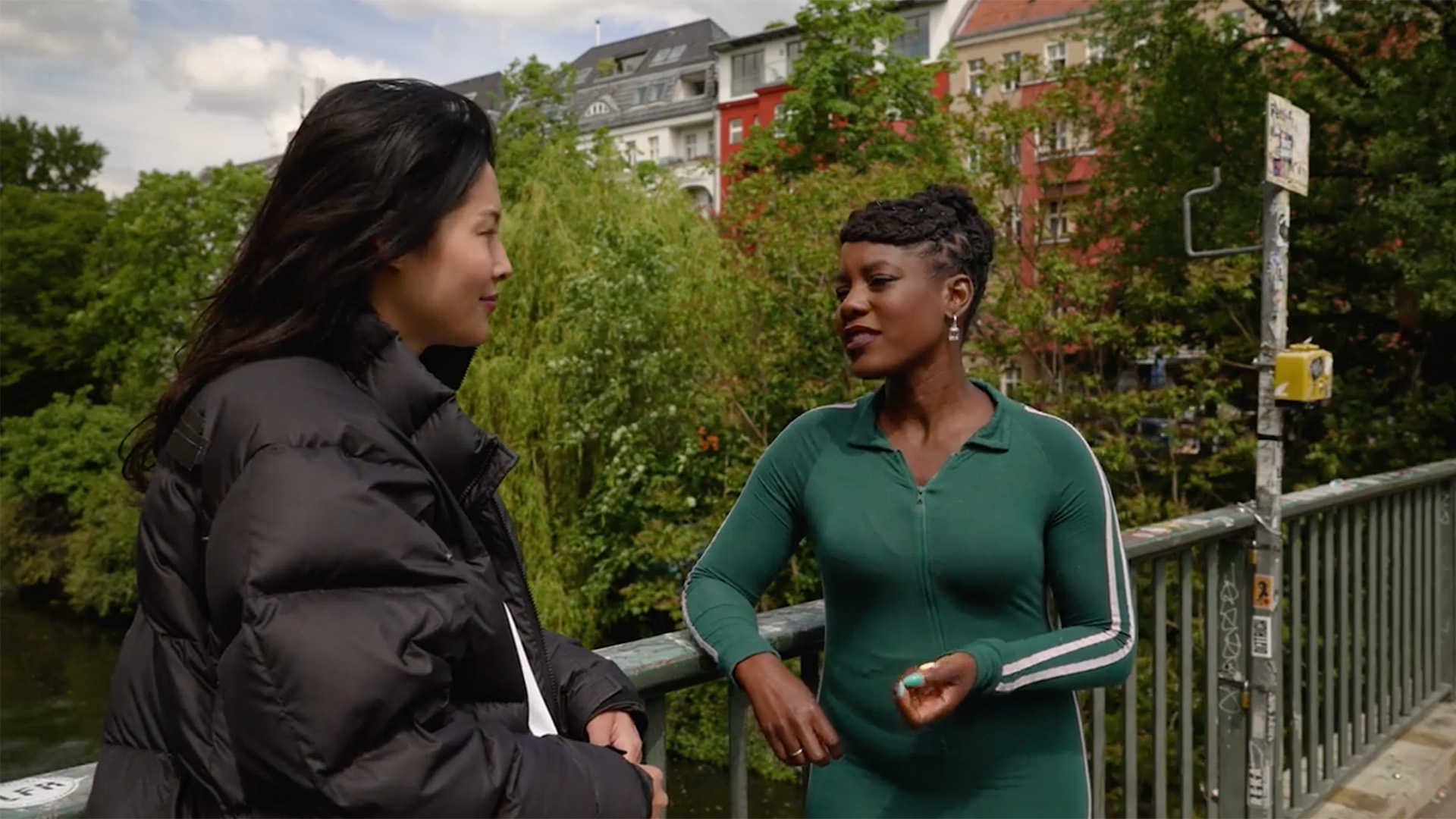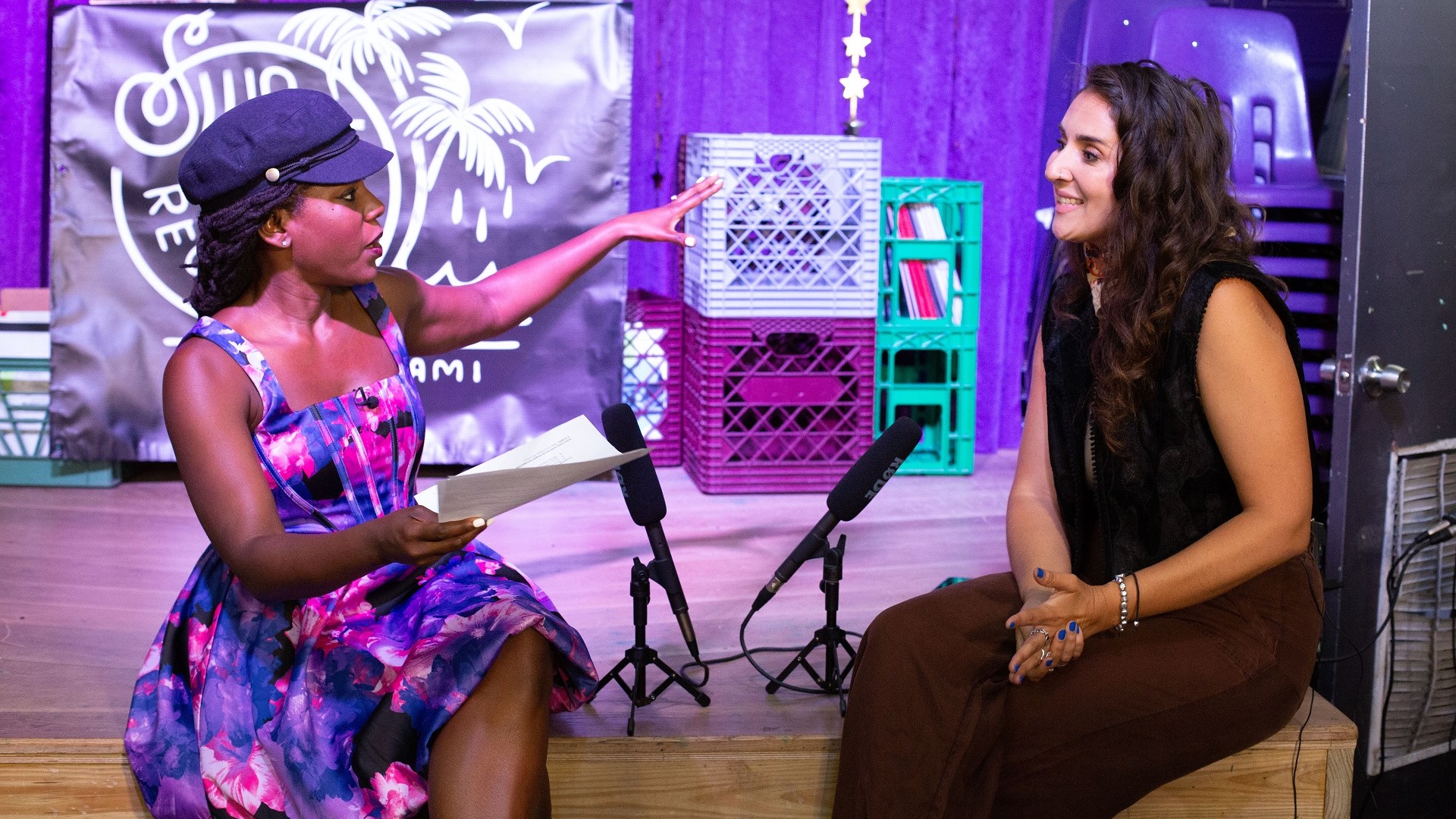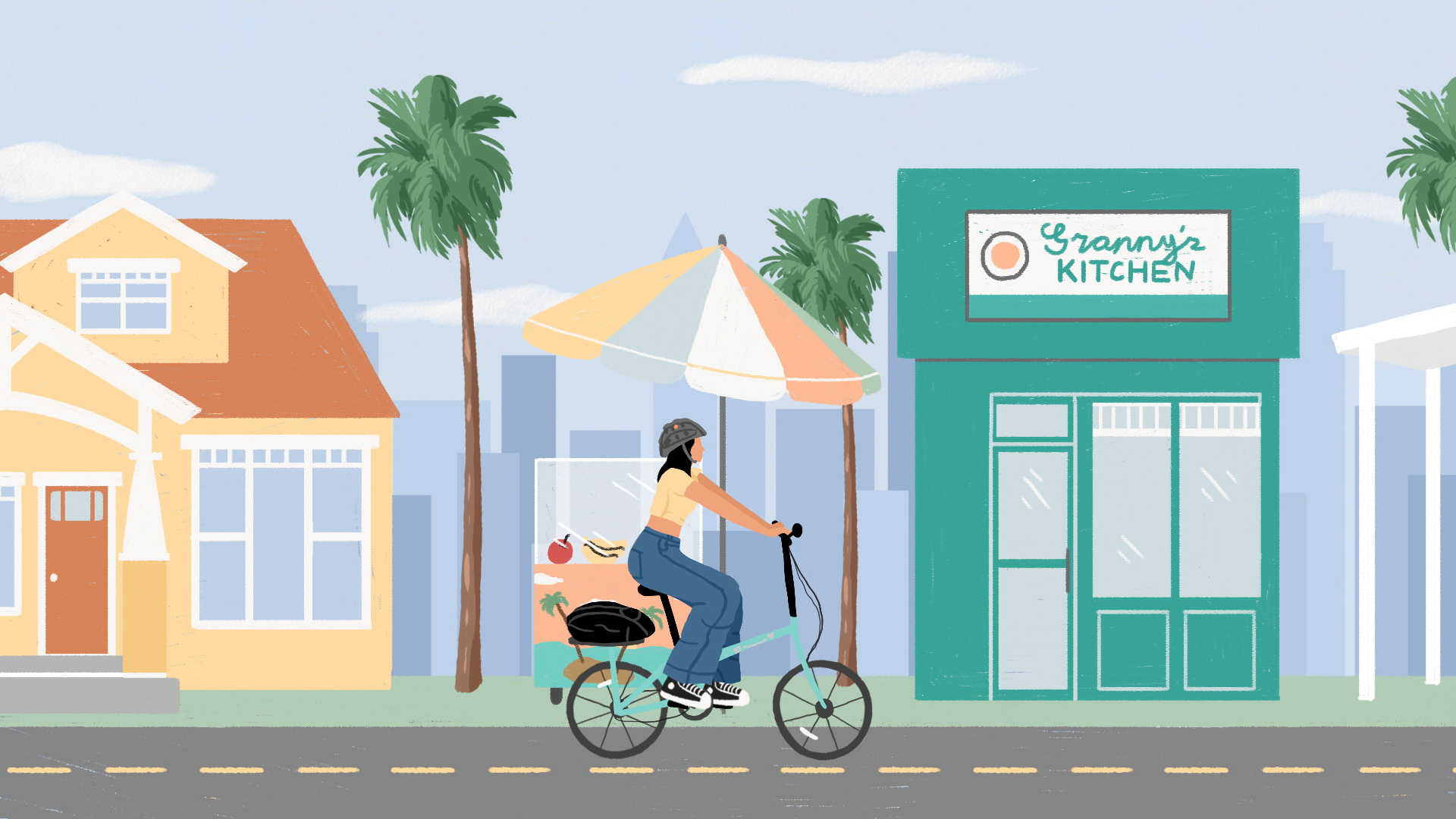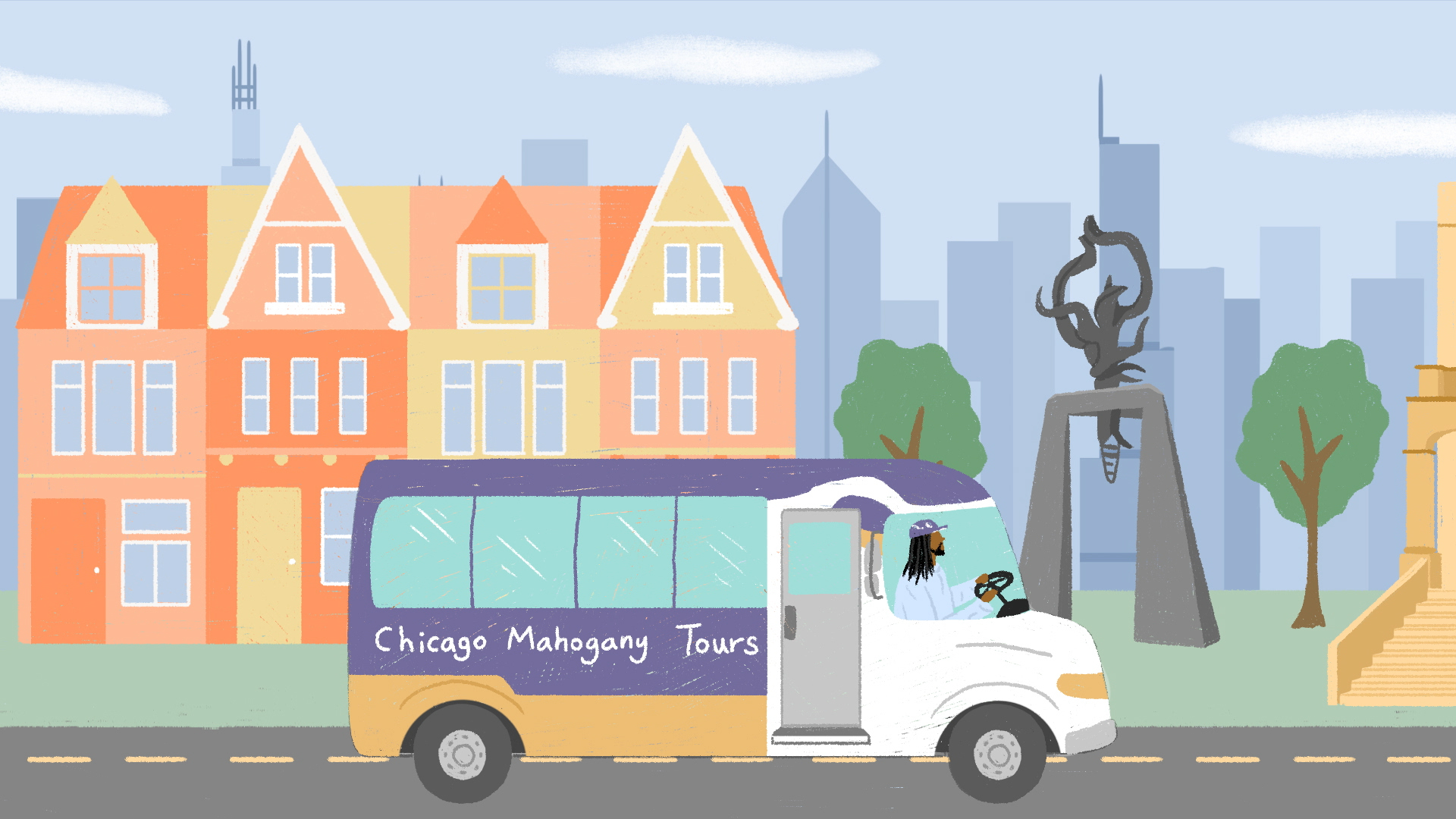
Tour Chicago’s Bronzeville neighborhood. (Illustration: Yeji Kim)
About the JourneyBronzeville, Chicago: Tour the City’s ‘Black Metropolis’ with a Local TikTokker and Historian
By Oneika RaymondOneika Raymond dials into Chicago’s Bronzeville neighborhood, where historian Sherman ‘Dilla’ Thomas takes us on a bus tour through the birthplace of gospel music and Black History Month located just four miles south of the city’s downtown.
Bronzeville has quickly become the most popular neighborhood tour that Dilla offers through his bus tour company, Chicago Mahogany Tours, thanks in part to the viral TikToks that Dilla makes to illuminate the history and contributions of Bronzeville, formerly known as the Black Metropolis.
On his tour, Dilla brings the energy of his TikToks, and the stories of Bronzeville, to life. We start out on Martin Luther King Jr. Drive, a road steeped in history. The 14-mile long street was renamed for Dr. Martin Luther King Jr. in 1968, making Chicago the first city in the country to name a street after the slain civil rights icon.As we drive the thoroughfare, we learn how Chicago’s Black community created its own thriving business and artistic community within its boundaries — which brings us to our next stop on the tour.
We roll through the Blues district on 47th street, home to the spirit and sounds of the electric Chicago Blues that filled this nightlife corridor in the 1930s. Along the way, Dilla points out the home of jazz great Louis Armstrong, one of a handful of jazz legends who lived in Bronzeville. We end our musical leg of the tour at the birthplace of gospel music, the National Museum of Gospel Music.
For the first time on the tour, we step off the bus at our next stop. We find ourselves standing in front of an impressive monument dedicated to Ida B. Wells Barnett called the “Light of Truth”. The 35-foot tall structure, built to honor the journalist and civil rights activist, is Chicago’s first monument officially designated to a Black woman.
We end the tour at Bronzeville Winery, and a neighborhood staple helping to shape a 21st-century version of the metropolis we just toured. Co-owner Cecilia Cuff shares how the winery supports community, from its wine list, which is made up of 75 percent minority or women-owned bottles, to the local artists, musicians and staffers it works with daily.
Then, Dilla heads to the DuSable Black History Museum and Education Center, the longest, for a full-circle conversation with Oneika. They discuss the impact that Bronzeville has had, not only on Chicago, but globally, and talk about the history that’s continuing to be made here today.
To read full episode transcripts from About the Journey and see photos of each featured destination, head to About the Journey on Marriott Bonvoy Traveler. Starting this season, you can also watch videos from select episodes on our Marriott Bonvoy YouTube channel.
PODCAST TRANSCRIPT
Shermann ‘Dilla’ Thomas (Field): You know, what kind of Chicago historian would I be to bring you through Bronzeville and not show you where Aretha Franklin did her thing?
Shermann ‘Dilla’ Thomas (Intv): I think the name in and of itself, Bronzeville calls for Inquisition. Right? You know, you’ve heard about Chicago, you heard about The Bean. Maybe you’re not familiar with Bronzeville, and so it’s like, what’s that?
Oneika Raymond (VO): Welcome to About the Journey. I’m your host, Oneika Raymond, a travel journalist and member of Marriott Bonvoy. This season, I’m uncovering the lesser known sides of six iconic cities. In my years of travel, I found there’s no better way to see a city than through its neighborhoods and the people who call them home.
So I’ll be meeting up with in-the-know locals to show me what makes their homes one of a kind. From the sights, sounds, and flavors, to the hidden gems, and so much more.
This week, we’re exploring Chicago’s Bronzeville neighborhood, the birthplace of gospel music and Black History Month, also known as the Black Metropolis.
Shermann ‘Dilla’ Thomas: Bronzeville would be the oldest Black neighborhood in Chicago. And so by that definition, we have the oldest Black churches, Black civic organizations.
Oneika Raymond (VO): Today we’re taking a tour of Bronzeville with Chicago historian Sherman ‘Dilla’ Thomas. Dilla is the founder of Chicago Mahogany Tours, a bus tour dedicated to highlighting the city’s history and impact.
Shermann ‘Dilla’ Thomas (Field): So welcome to Bronzeville. Let’s have a round of applause from Bronzeville. At the end of the tour, you will agree with me that everything dope about America comes from Chicago.
Oneika Raymond (VO): Then, I sit down with Dilla for a conversation about Bronzeville’s bright future, and how travelers can support it.
Shermann ‘Dilla’ Thomas (Intv): There’s such an amazing resurgence going on here now. It’s what was formerly the Black Metropolis, and now it’s returning to be a metropolis, but a metropolis more inclusive to the people that are here.
Oneika Raymond (VO): Chicago is a city of neighborhoods: seventy-seven to be exact. And each one boasts its own character, style, and things to do. But for a true piece of Chicago history, you have to head four miles south of downtown to Bronzeville.
Vox Pop – Kendi Amani: Bronzeville is such a gem of a place. It’s very hidden, but we have everything here. It’s a real neighborhood with a lot of heart.
Vox Pop – TBD: It feels like you never met a stranger when you come to Bronzeville.
Vox Pop – William Burke: Cultured and historical.
Vox Pop – Sharon Ponder: We have such a rich history, here in Bronzeville, of African-American journalists to business people. Bronzeville Black-owned restaurants, cafes, establishments are a must when you visit my beloved hometown of Chicago.
Oneika Raymond (VO): Bronzeville is getting its flowers both nationally and globally, and it’s thanks in part to Dilla Thomas, who started creating quick Chicago history videos on TikTok for fun, and then went viral.
Sherman ‘Dilla’ Thomas (TikTok): Yo, what’s up? It’s your favorite neighborhood historian, Dilla. I personally know that everything dope about America was either made in, or made better by, Chicago. Let me give you a couple examples…
Shermann ‘Dilla’ Thomas: I think it’s the connection to the stories I tell on social media. You may want to come physically see that.
Oneika Raymond (VO): So, Dilla started his Chicago tours. Now, while he offers tours of neighborhoods across Chicago, his Bronzeville tour remains the most popular. We sent a producer to join the historic tour before I sat down with Dilla to talk about Bronzeville today. And let me tell you, it has me hyped to go see Bronzeville for myself.
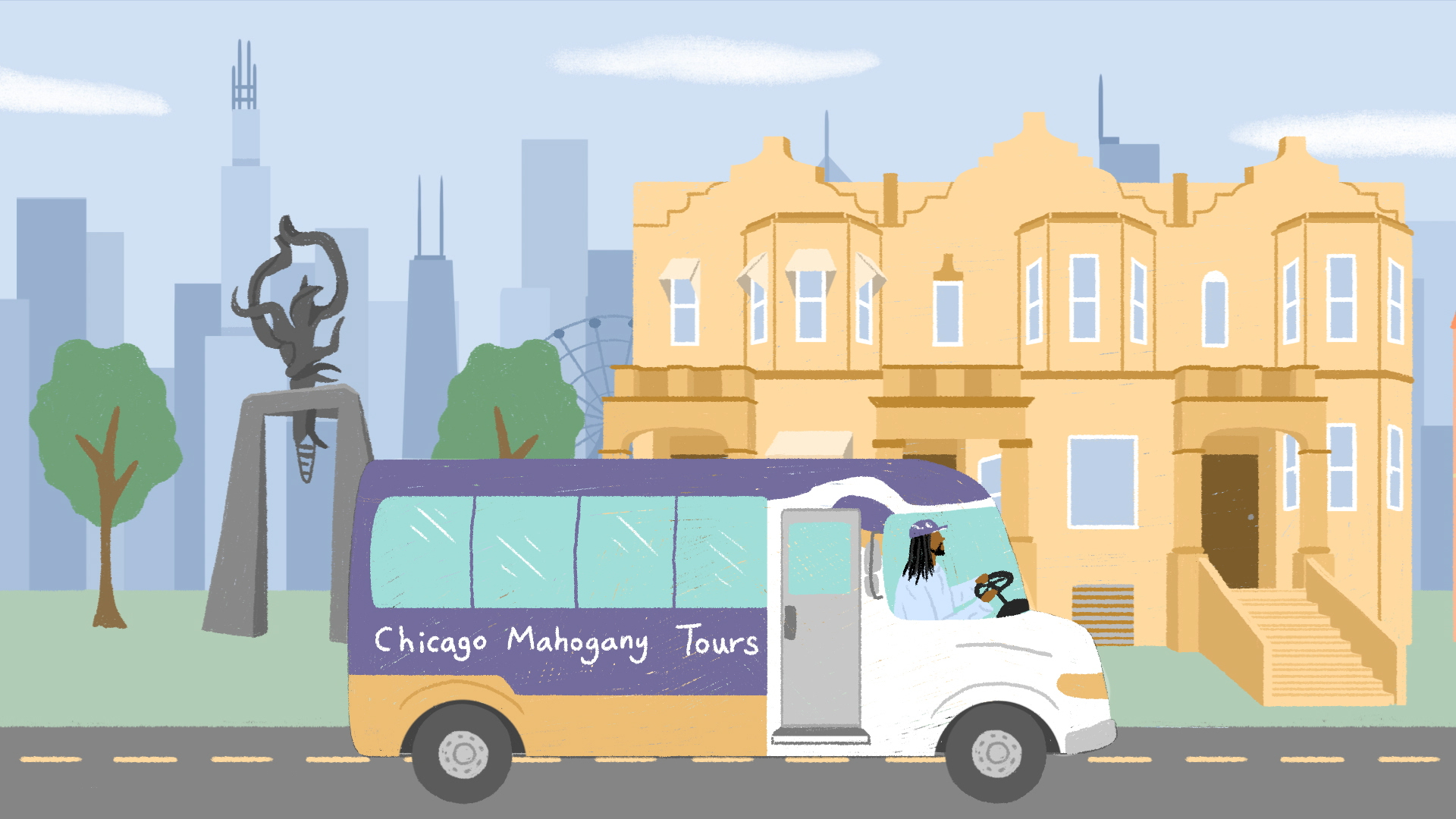
Shermann ‘Dilla’ Thomas (Field): So my name is Dilla. I fancy myself a Chicago historian. Born and raised in this amazing city — grew up on the South Side, went to…
Oneika Raymond (VO): One thing about Dilla, he commands the front of the tour bus with ease. And it comes as no surprise. As a father of seven, he’s used to engaging a crowd with a good joke or story.
Shermann ‘Dilla’ Thomas (Field): I’m the son of a Chicago police officer. My dad was a cop for 32 years in this city. So if you couldn’t tell him that here in Chicago on the west sides of the street, that the numbers ended in an even number, you couldn’t touch his car.
[crowd laughter]
And so to be able to use his car, I learned the Chicago Street grid, so that way I could pass all his tests.
Oneika Raymond (VO): Dilla often chooses the exact route of his Bronzeville tour based on the mood of the passengers and traffic. Today, that means driving down 47th Street toward Martin Luther King Drive, a road steeped in history.
Shermann ‘Dilla’ Thomas (Field): Heading on King Drive…Chicago is the first city in this country to name a street after the slain civil rights icon. Dr. King was sadly killed April 4th, 1968. We changed the name of South Parkway Boulevard in July of 1968.
Oneika Raymond (VO): Dr. Martin Luther King Jr. moved to Chicago’s West Side in 1965 to lead the Chicago Freedom Movement. It was a campaign that focused on fair housing for Chicago’s Black community.
Shermann ‘Dilla’ Thomas (Field): And so the Black folks in Bronzeville sat in the middle of neighborhoods that had restrictive racial covenants, so Black folks couldn’t live anywhere else.
Oneika Raymond (VO): Forced to plant roots in Bronzeville, the neighborhood became a safe haven for Chicago’s Black community. Here, Black business boomed, and as a result, a cultural renaissance was unleashed.
Shermann ‘Dilla’ Thomas (Field): So the Chicago Blues District runs between 47th Street and 43rd Street, both sides of the street had very awesome blues clubs and various activations.
Raise your hand if you’ve been to New Orleans. Oh, whole bus has been to New Orleans. Now, I’m not saying that jazz was not invented in New Orleans. It was, but it was not called ‘jazz’. It was called ragtime and dixie. And then in the 1900s, the Mayor of New Orleans said that Black folks could no longer perform in public. So these ragtime and dixie players move to Chicago to perform here.
They have a show at the Palm Cafe, which is still standing today — it’s on 35th Street. A Chicago Tribune writer goes to hear the show. The Tribune writer thought the show sucked. So he said, “It sounded like a bunch of ‘jazz’ in my ear.” The musicians thought that that was the coolest word ever. So they started calling their music ‘jazz’. So Chicago didn’t give birth to jazz, but we certainly named it. And I think that name is dope.
Oneika Raymond (VO): Bronzeville was home to some of the top jazz musicians of all time. Greats like Nat King Cole and Dina Washington all lived here.
Oneika Raymond – VO: And by the way, that’s Louis Armstrong’s home…has the horns in the window, has the Chicago tribute sign.
Oneika Raymond (VO): Music thrived in the creative energy of Bronzeville. Blues musicians like Muddy Waters mixed with soul and rock artists to create entirely new musical subgenres, like the electric Chicago blues.
Music Interlude continues – Blues fades out, gospel music fades in
Oneika Raymond – VO: With the sounds of Bronzeville’s Blues District ringing in our ears, we cut a few blocks west to Indiana Avenue and drive up to 33rd Street to our next iconic music stop, Pilgrim Rest Baptist Church.
Shermann ‘Dilla’ Thomas (Field): So let me tell you about the National Museum of Gospel Music.
Music Interlude – light percussion
Shermann ‘Dilla’ Thomas (Field): There’s this gentleman by the name of Thomas Dorsey. He was a percussionist. He fell in love and got married. Sadly, his girl died during childbirth. and his son passed in the night, and so when his heart tore up, he wrote like an activation of God. So he sat at his piano and he played a slow jazz melody. And that moment in time is considered the birth of gospel music for this country. Today, we call that song Precious Lord, and it has a lot to do with this space.
Gospel music fades out
Oneika Raymond (VO): We leave the cradle of gospel music to head to our next stop. For the first time on the tour, Dilla puts down the microphone and invites the group to join him off the bus.
SFX – bus door opening
Shermann ‘Dilla’ Thomas (Field): Please read the tablets inside of the monument. I will join you over there.
Oneika Raymond (VO): The tour gathers around a bronze and marble sculpture with three sturdy legs at its base, and a flame-like shape that reaches into the sky.
Shermann ‘Dilla’ Thomas (Field): We are here because this is the first monument in the city of Chicago officially designated to an African American woman. It’s Ida B. Wells Barnett.
Oneika Raymond (VO): Ida B. Wells Barnett brought her crusading spirit to Chicago in 1893.
Shermann ‘Dilla’ Thomas (Field): If you read this amazing tablet, the thing I’d like to point out is that, 1) sadly, she was born into chattel slavery. She was freed via the Civil War, and then this calls her a pioneering data journalist — “Hey Dilla, what is that?” Well, basically, she would hear about a family or someone being lynched and she would travel to that city so she could get the first person’s story. She would always write those stories under a pen name until she was discovered, and that’s what sent her to Chicago.
Oneika Raymond (VO): Here, the journalist and civil rights activist founded Chicago’s first-ever Black women’s suffrage club. And she helped other activists, whose names we celebrate today, find their own footing in the city.
Shermann ‘Dilla’ Thomas (Field): We were, at that time, having the World’s Fair. Daniel Burnham asked Susan B. Anthony to come to Chicago to speak at the World’s Fair. So Susan B. Anthony was like, “Yeah, I’ll be there.” He was like, “Yeah, wait, wait, wait. What are you getting ready to talk about?” She was like, “Nothing, women’s right to vote.” He’s like, “Oh nah. You ain’t finna say that here.” And so he removed his invitation.
[crowd laughs]
He did, right. So Ida B. Wells then invited Susan B. Anthony to give a speech at Quinn Chapel to push for women’s suffrage. We know Chicago helps pioneer that.
Oneika Raymond (VO): Ida B. Wells Barnett also devoted herself to educating her city’s youth. She opened Chicago’s first kindergarten for Black children in 1897. And today, her commitment to education lives on in Dilla’s tour.
Shermann ‘Dilla’ Thomas (Field): Now, Brown girls are learning about the very awesome Ida B. Wells Barnett. So that’s the reason I make people get off the tour on Bronzeville only here. We have to honor public people in public spaces for the benefit of us all.
Oneika Raymond (VO): All of the work that Dilla does to preserve Bronzeville’s past is in deep service of building a bright future. He’s able to show a glimpse of what that might look like with the last stop on his tour.
Shermann ‘Dilla’ Thomas (Field): And then if you’re not in a rush get some awesome wine from the Bronzeville Winery.
Oneika Raymond (VO): Bronzeville Winery is the neighborhood’s first ever winery, and co-founder Cecilia Cuff is central to creating a 21st century version of the metropolis we just toured.
Cecilia Cuff: We knew that coming together as a community was something that was really needed, especially on the South Side of Chicago.
Oneika Raymond (VO): Cecilia teamed up with Eric Williams, another leading Black entrepreneur in Chicago, to open Bronzeville Winery as a space that’s fiercely by, and for, community.
Cecilia Cuff: We now proudly have a list that’s about 75% either minority or female-owned for our wines, beers and spirits. Many of them are right around our corner. When we started to think about the build out of the space, we thought about, how do we create community reciprocity? So what that meant to us was, how many local jobs can we create? I think we were very thoughtful about the way we wanted to drink wine as a community.
Oneika Raymond (VO): On any given day, Bronzeville Winery is buzzing with activity. It’s become a beloved watering hole for drinking and dining, being in community, and connecting across the table, from generation to generation.
Cecilia Cuff: What feels very centered and rooted is that we’ll see people who have been here generationally for 50, 60, 70 years, and they’re able to share their accounts of what they never thought they would see again in their own community. And to articulate what the rewriting of the history of Bronzeville looks like.
Music cue – sting
Oneika Raymond (VO): Dilla heads from Bronzeville Winery to the DuSable Museum of African American History to join me for a full circle conversation. We discuss the impact that Bronzeville has had, not only on Chicago, but globally. And we talk about the history that’s continuing to be made here today.
Oneika Raymond: You are known as Chicago’s favorite neighborhood historian. What does it mean to you that you’ve essentially been given this title? Like how does that feel?
Shermann ‘Dilla’ Thomas: It’s very humbling. I feel very much connected to Chicago. My mom was a nurse here. I’m public school educated. The entirety of my life, if a book had the name ‘Chicago’ in it, we couldn’t leave the store unless I had it. So, I don’t think I understood that I was preparing myself for this. But I’m very much well-studied and well-versed in Chicago history.
Oneika Raymond: So very much a cultural ambassador.
Shermann ‘Dilla’ Thomas: Yeah. And I think I’m fortunate enough that my life’s experience has allowed me to work in Chinatown, to work in the Polish downtown, to work in the, Puerto Rican neighborhood of Paseo Boricua, to work in the Irish neighborhood of Bridgeport, to work in the Japanese neighborhood on Argyle street. And so as a Black dude that loves Jordans, I also have an appreciation for everybody’s Chicago story because of the amount of time I’ve gotten to spend with people and learn their Chicago stories. And then it just dawned on me that a lot of things that we love come from Chicago. You know, they’re playing the Chicago-style of Blues in Tel Aviv. In Paris, all of the Black luminaries were welcoming in open arms Josephine Bakers and others in the ’30s. So we’re very much world citizens, and I just want to do my part.
Oneika Raymond: Yeah, there isn’t just a single story of Chicago. So right now you are at the DuSable Museum of African American History. Tell us a little bit about the museum for us to get to know Bronzeville.
Shermann ‘Dilla’ Thomas: I’m very glad that you asked that. The DuSable Museum of African American History is the longest, continuously running Black history museum in this country. It’s a great starting point to highlight the rich history of Chicago, and particularly Bronzeville.
Oneika Raymond: and Bronzeville absolutely stands out. Let’s talk about what it’s like right now. What is Bronzeville today? We have churches, we have businesses, Black-owned businesses. What does that look like to the traveler who is literally in the streets?
Shermann ‘Dilla’ Thomas: So there are a number of black businesses that align our east and west arterial streets here in Bronzeville. So you’re gonna smell barbecue. You’re gonna, uh, see people coming out of coffee shops. You’re gonna hear varying types of music, right? You’ll hear hip hop, jazz, drill, Blues. We’re out there jamming and doing the salsa, as well, in Bronzeville. And then I would say you’re also going to see a lot of art, beautiful murals, and art that highlights the rich history of the space.
Oneika Raymond: You know what I love about your description is that there’s so many things going on, you talked a lot about, I guess, the multicultural nature of the neighborhood. It’s not culture that’s monolithic, right? So it’s actually really multifaceted. And that’s something that I can appreciate. You know, if I’m there for an afternoon, like, what do I need to hit up?
Shermann ‘Dilla’ Thomas: We always have to start with food. You need to go to Chicago Chicken and Waffles, and the restaurant is inside of what was one of the first ‘nickelodeon’s’ on the South Side — ‘nickelodeon’ being a place where you watch a movie for a nickel, alright? So, you get the history and great food. And then there’s the Rosenwald Courts. A gentleman by the name of Julius Rosenwald, who was the Chairman of Sears, Roebuck and Company back in the 19-teens and ’20s. He became good friends with Booker T. Washington and he discovered that African Americans didn’t have a place to stay. So, he bought an entire city block, knocked down all the property and built what’s probably, like, a 150-unit building today. It’s called the Rosenwald Courts. Every single person in Bronzeville knows where that is, and it’s a very architecturally beautiful place. So I would say those are the places you for sure, for sure have to hit up. Honey’s Barbecue for lunch. Washington Park — it’s one of the parks that was designed by the same dudes that designed Central Park, the Almstead Brothers. So, I would say those are great places to start.
Oneika Raymond: If you were to write the next chapters of the book of Bronzeville, what stories would you want to fill those pages with?
Shermann ‘Dilla’ Thomas: Goodness. I hope that we are able to become innovative and allow for new spaces to be built, while at the same time hoping that Bronzeville continues to keep the historic buildings that we have. Preserve the history that we have in order for it to be shared for future generations. And then lastly, I would simply just like for Bronzeville to be thought of as much as one thinks of visiting Navy Pier, or one comes to Chicago and wants to visit the North Side or Wicker Park or Lincoln Park. You know, I want you to come to Hyde Park. I want you to go see where Michelle Obama and Barack Obama live. I want you to go do those “normal” Chicago things, but I want Bronzeville to be thought of in those same veins.
Oneika Raymond: Well, you know what, Dilla, you are certainly putting Bronzeville on the map with your amazing storytelling and your tour. So thank you so much for joining us.
Music plays for a few beats then…
Oneika Raymond: This has been such a lovely conversation.
Shermann ‘Dilla’ Thomas: Thank you and Thank you very much.
Oneika Raymond (VO): After the conversation wrapped, I stayed on the line for a bit longer with our editorial director, Robin, to share what we took away from our time with Dilla.
Oneika Raymond: He was great.So passionate. And his storytelling, it’s not just like a one way storytelling.
Robin Bennefield: Yeah, and I love how he just connected Bronzeville to the larger Chicago story.
Oneika Raymond: Mm hmm. Because so often with these major metropolises, you lose…like the “greater” area, the “greater” Miami area, the “greater” Toronto area, the “greater” Chicago area. And so these really large neighborhoods, and impactful neighborhoods, are lost in the sauce, so to speak. So it’s nice that we’re able to kind of grab out, you know, the story of this particular place, which is very significant and very important historically and culturally.
Theme Music fades in
Oneika Raymond (VO): That’s all for this episode of About the Journey. Thank you so much to our Bronzeville guide, Dilla Thomas. Next week, we’re headed to Berlin, to the neighborhood of Kreuzberg, for our season finale. We’re diving headfirst into the city’s burgeoning women driven culinary scene.
Dalad Kambhu: You know a lot of female chefs are in Berlin and surprisingly, a lot of them are here.
Oneika Raymond (VO): About the Journey is produced by Marriott Bonvoy Traveler, At Will Media, and me, Oneika Raymond. Our Marriott producers are Robin Bennefield and Valerie Connors. Our AT WILL MEDIA producers are Kait Walsh, Kristy Westgard, Gale Straub, and Elliot Davis. Mixing and original theme music by Andrew Holzberger.
Learn more about Dilla Thomas and follow along with him on TikTok at 6figadilla. Find out more about Chicago Mahogany tours at chicagomahogany.com.
You can learn more about visiting Bronzeville and how to travel more meaningfully from Marriott Bonvoy Traveler at traveler.marriott.com. Stay, explore, and discover the unexpected with Marriott Bonvoy’s 30 plus hotel brands and over 8,000 hotels in cities around the world.
And if you liked this episode of About the Journey, please be sure to rate, review, and subscribe wherever you get your podcasts.
I’m your host, Oneika Raymond. See you next time.







